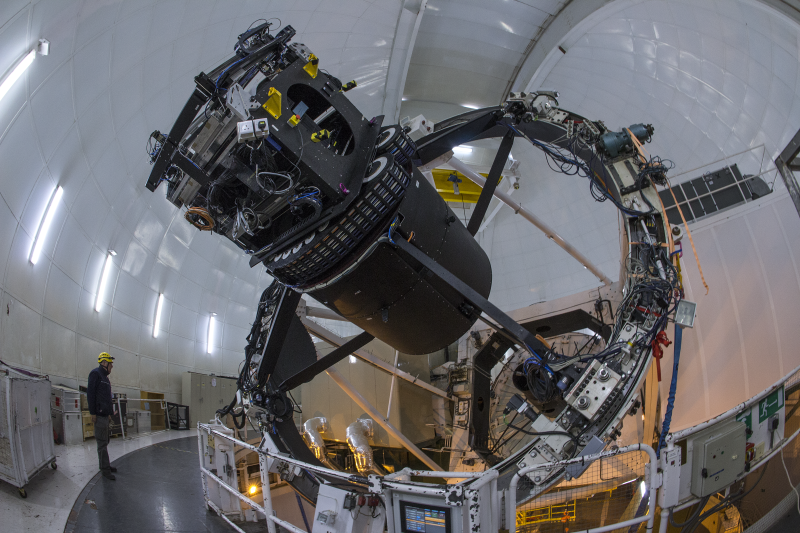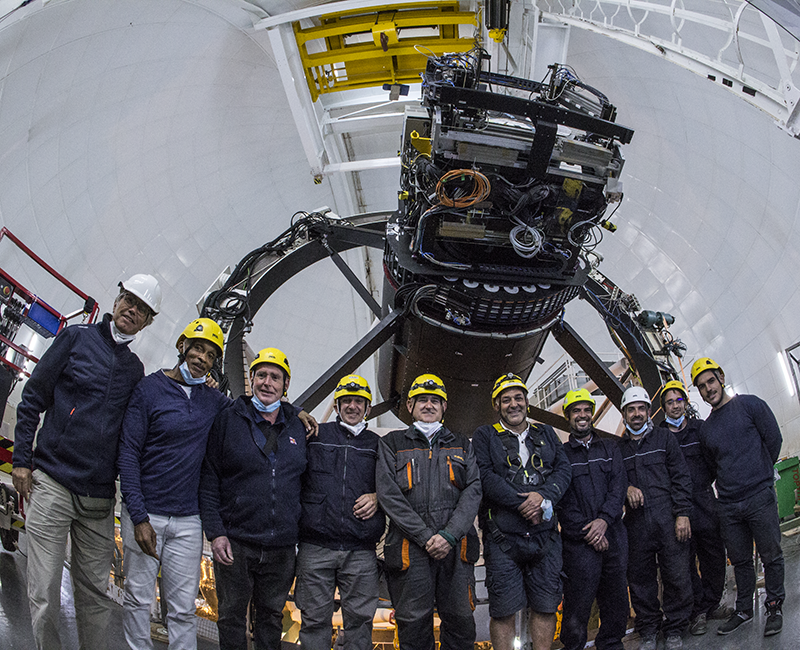ING Press release
26 May, 2022
The WEAVE Instrument, Mounted on the Prime Focus of the WHT
ING is pleased to announce that, on Wednesday 25 May 2022, the WEAVE prime focus unit was successfully mounted on the WHT. The prime focus unit hosts the six large lenses of the optical corrector, the instrument rotator, the fibre positioner with its two robots, and nearly 4000 optical fibres. After assembling the positioner to the corrector on Monday, and arranging cables and fibres on Tuesday, the entire assembly, weighing 7.7 tons, was lifted on Wednesday. Once attachment to the prime focus ring of the telescope was completed, the pre-tensioning elements were installed. Eight mechanical engineers and technicians from the ING staff completed the lift in close to 9 hours.
In the coming days, work continues running the fibre cables to the spectrograph, installing the control electronics cables, and completing the tensioning of the telescope vanes. The system will then be ready for continuing calibration and verification tasks on the positioner. WEAVE on-sky commissioning is planned for this summer, after which the observations of the science verification programme will be carried out in the fall.
|

| WEAVE on the WHT. Credit: Javier Méndez. Large format: PNG.
|

| Smiles at the end of the day: some of the mountain-top team responsible for installing WEAVE on the WHT on 25th May 2022. From left to right: Marc Balcells, Don Carlos Abrams, Kevin Dee, Roberto Martínez, Amado Guillén, Servando Rodríguez, Servando Rodríguez Jr, David González, Daniel Brito and Joel Concepción. Credit: Javier Méndez. Large format: PNG.
|
About WEAVE
The ING initiated plans to build WEAVE after extensive consultation with the ING user community about what was needed for the future. There was a broad consensus that a world-class wide-field multi-object spectrograph was required to exploit from the ground the huge surveys being undertaken by powerful telescopes such as as ESA's Gaia, thereby helping to address the main astrophysical challenges foreseen for the next decade.
In 2016, the multi-lateral agreement to design and build WEAVE was signed by the countries of the ING partnership (the UK, Spain and the Netherlands), joined by France and Italy, with each country contributing major components as listed below, and with the ING providing auxiliary systems and overall project management.
The consortium is led by Gavin Dalton from the University of Oxford and RAL Space as Principal Investigator, Scott Trager from the University of Groningen as Project Scientist, Don Carlos Abrams from the ING as Project Manager, and Chris Benn from the ING as Instrument Scientist. The main components of WEAVE are:
- Fibre positioner, developed by the University of Oxford in the UK, with support from the Instituto de Astrofísica de Canarias (IAC) in Spain.
- Prime-focus system, designed by ING, IAC and SENER, provided by the IAC and manufactured by SENER. Support from Konkoly Observatory (HU). Lenses were polished by KiwiStar in New Zealand, funded by STFC, NOVA, INAF, IAC and ING, and mounted at SENER Aeroespacial (ES) by SENER and ING.
- Spectrograph, built by NOVA in the Netherlands with optical design by RAL Space in the UK, optics manufactured at INAOE (MX) and with support from INAF (IT) and the IAC.
- Field rotator, provided by IAC and manufactured by IDOM (ES).
Optical fibres, provided by the Observatoire de Paris in France, manufactured in France, Canada and USA.
- LIFU, built by NOVA (NL).
- CCD detector system, provided by Liverpool John Moores University in the UK.
- Data processing, analysis and archiving led by the University of Cambridge (UK), IAC (ES) and FGG-INAF (IT), respectively.
- Observatory control system, built by the ING.
WEAVE's construction has been funded by the Science and Technology Facilities Council (STFC, UK), the Netherlands Research School for Astronomy (NOVA, NL), the Dutch Research Council (NWO, NL), the Isaac Newton Group of Telescopes (ING, UK/NL/ES), the Instituto de AstrofÃsica de Canarias (IAC, ES), the Ministry of Economy and Competitiveness (MINECO, ES), the Ministry of Science and Innovation (MCI, ES), the European Regional Development Fund (ERDF), the National Institute for Astrophysics (INAF, IT), the French National Centre for Scientific Research (CNRS, FR), Paris Observatory – University of Paris Science and Letters (FR), Besançon Observatory (FR), Region Île de France (FR), Region Franche-Comté (FR), Instituto Nacional de Astrofísica, Óptica y Electrónica (INAOE, MX), National Council for Science and Technology (CONACYT, MX), Lund Observatory (SE), Uppsala University (SE), the Leibniz Institute for Astrophysics (AIP, DE), Max-Planck Institute for Astronomy (MPIA, DE), University of Pennsylvania (US), and Konkoly Observatory (HU).
More information:
About the Isaac Newton Group of Telescopes
The Isaac Newton Group of Telescopes is a unit of the Science and Technology Facilities Council (STFC) established on La Palma. It operates the William Herschel Telescope and the Isaac Newton Telescope with financial assistance from the Nederlandse Organisatie voor Wetenschappelijk Onderzoek (NWO) of the Netherlands, and the Instituto de AstrofÃsica de Canarias (IAC) in Spain.
|
|



